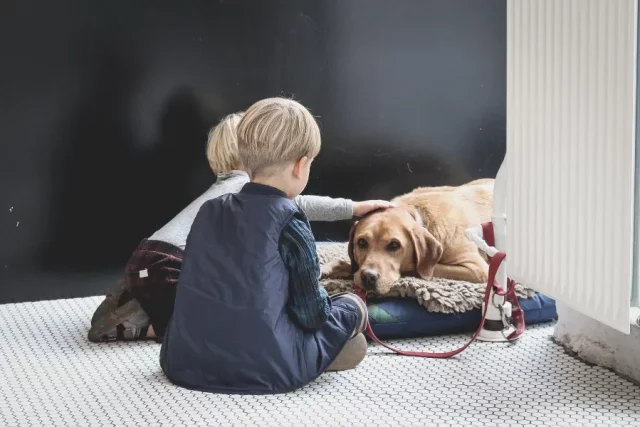If you want to teach your dog new tricks and make them obey you, learning how to communicate with them is crucial. Being aware of a dog’s individual needs is vital to successfully connecting and understanding each other.
Here are some tips for better communication with your dog.
Limit Eye Contact
Whether you have white lab puppies for sale or rescue dogs, what never changes is a dog’s sense of hierarchy.
They take comfort in knowing who is in charge. On the other hand, they also react adversely to consistent attempts to dominate the situation.
Even though it’s normal for people to sustain eye contact, dogs find it domineering, and dominance training isn’t an effective way to communicate with your dog. You need them to focus, but you don’t want them only to fear you.
For better communication with your dog, keep eye contact to a minimum.
Use Command Words
One of the most effective ways to communicate with your dog is to use command words. The best command words are simple and can be taught quickly through clicker use or treat motivation.
Be Consistent
It doesn’t matter what command words you pick as long as your dog understands them. If you wanted, you could teach them that ‘orange’ is synonymous with ‘come here.’ The key is to be consistent.
In order to enhance the efficiency and clarity of dog training, it is crucial to avoid the use of multiple words or phrases that convey the same meaning. For example, when teaching a dog the command to ‘come,’ it is important to refrain from using alternate phrases like ‘over here.’ Such synonymous words can hinder the training process, leading to confusion for the dog and slower progress. This principle of clear communication and consistency is not only emphasized in dog training but also extends to those investing in a pet franchise. By maintaining a uniform vocabulary and methodology, franchisees can deliver effective training services, ensuring a seamless experience for clients and contributing to the overall success of their franchise venture, regardless of location.
Pick Distinct Command Words
Another tip for better communication with your dog is to ensure your command words are distinct.
For instance, ‘come by’ is a popular variation of ‘heel.’ But it’s easily confused with ‘come.’ Using both of these commands may confuse your dog and affect how well you communicate with them.
You need many different words that you can use repeatedly and without embarrassment in public. They should all sound different from each other to help your dog understand best.
Prioritize Positive Reinforcement
The efficacy of dominance training had been disproven, though it’s sometimes necessary for naturally aggressive dogs. However, your average Fido will find it upsetting.
For better communication with your dog, try reinforcing good behavior through rewards. These build a positive association between you and the action the dog performs. Positive reinforcement encourages your dog to repeat the action the next time you ask for it.
Even better, your dog won’t be afraid of coming when called.
Adopt A High-Pitched Voice
Another tip for promoting better communication with your dog is to use a high-pitched voice.
Using a different voice can feel silly, but dogs find those high-pitched, squeaky voices soothing and non-threatening. Adopting one when talking to your dog makes them feel safer.
Additionally, because dogs rely on their nose and ears more than their eyes, a high-pitched voice helps them focus on you. That’s doubly true when they are somewhere with many distractions, like a park or dog run.
Minimize Distractions
One of the best tips for better communication with your dog is to minimize distractions.
Anyone with a puppy will tell you there are gnats with wider wingspans than the canine attention span. That’s okay. When training your dog, always start somewhere quiet. Avoid anything that might take their attention off you, like:
- Toys
- Other dogs
- Music
You can incorporate more distractions as your communication gets better. But when you start working with your dog, you want them to be as focused on you as possible, and the less you have to compete with, the better.
Learn Your Dog’s Body Language
Knowing your dog’s body language also helps develop better communication between you and your dog.
Humans think dogs communicate through barking, but they have several ways of talking, including through their eyes, tail, and posture. Knowing when your dog is relaxed versus when they’re upset, afraid, or in distress significantly improves communication.
It may even help you realize your dog isn’t acting up purposefully. It could be a sign of trauma or distress.
Integrate Non-Verbal Commands
Since dogs don’t rely exclusively on vocalization to communicate, neither should you. Sometimes the best tip for better communication with your dog is to integrate gestures into your routines.
Body language can help focus your dog’s attention, and it is less likely to get lost in the auditory confusion of dog parks.
However, it takes time for dogs to learn non-verbal gestures. Your best bet is associating a gesture with a specific command word early in the training session. You can phase the command word out as your dog’s training progresses.
The other benefit is that if your dog loses their hearing, you’ll already have an effective communication system in place.
Go Back To The Beginning
If nothing’s working, it’s time to go back to the basics. Instead of getting frustrated when your dog can’t master a command, pivot to something the dog excels at.
It allows you to reward them for good behavior and rebuilds whatever bond your mutual frustration has damaged.
Remember, dogs are never deliberately malicious. If they’re struggling with a command, there’s probably a reason. The important thing is to exude patience and take time to understand how your dog communicates.
Context Is Everything
How you use verbal commands also affects your dog. One way that training can go wrong is if you use commands in a way that your dog thinks is bad.
‘Come’ is an excellent example. Imagine your dog enjoying the local dog run. You call your dog over, and the dog comes to heel. You respond by immediately attaching the leash.
Most dogs don’t want to leave the park because that’s where they socialize and expend energy. If you don’t take a minute to praise your dog’s recall, there’s a chance ‘come’ develops a negative connotation. That makes your dog reluctant to respond.
Always Reward Your Dog
Finally, always praise your dog when they do what you ask. Rewards can be treat-based or play-based, such as giving them a tug-of-war session. Different dogs are motivated differently. Know what your dog responds to best and integrate it into your training process.
Final Thoughts
Hopefully, these tips for better communication with your dog will prove helpful. Remember that training a dog takes time. Like people, some dogs learn faster than others. So choose distinct command words, keep the treats handy, and be patient.














